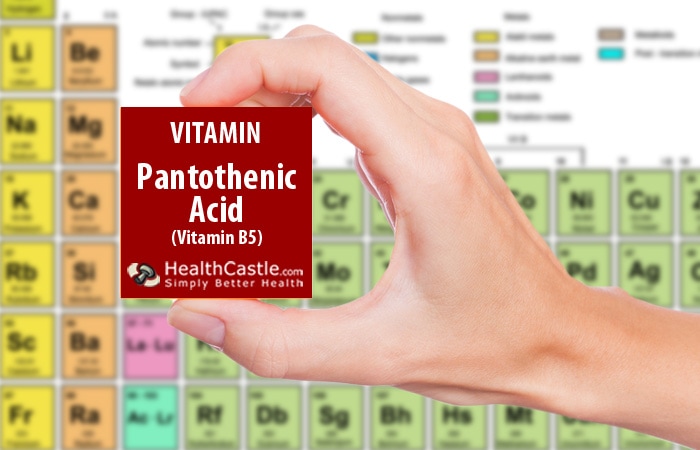
Written By: Carolyn Berry, RD
Title: Registered Dietitian
Alumni: University of British Columbia
Last Updated on:


Pantothenic acid is one of 8 B vitamins. All of the B vitamins are water soluble, meaning that the body does not store them but excretes them in the urine. Other names for pantothenic acid include pantothenate and Vitamin B5.
Table of Contents
The Dietary Reference Intakes (DRI) for pantothenic acid are shown below:
| Age Group | Adequate Intake (AI) per day | Tolerable Upper Intake (UI) Levels |
| Adults | ||
| 19 years and up | 5 mg | No upper limit is established for this nutrient |
| Kids and Youth | ||
| 1 to 3 years | 2 mg | |
| 4 to 8 years | 3 mg | |
| 9 to 13 years | 4 mg | |
| 14 to 18 years | 5 mg | |
| Special Considerations | ||
| Pregnant women 14 years and up | 6 mg | |
| Lactating women 14 years and up | 7 mg |
Because pantothenic acid is water soluble, excessive intake of pantothenic acid–containing foods has not shown to be toxic to humans.
Like the other B vitamins, Pantothenic acid’s main role is to help your body use carbohydrates, protein, and fat to make energy. Pantothenic acid is used for the synthesis of Coenzyme A (CoA), an enzyme that participates in a variety of reactions in the body, especially the breaking down of fatty acids. B-complex vitamins are also needed for healthy skin, hair, eyes, and liver. They also help the nervous system to function properly.
Pantothenic acid is critical for the synthesis of red blood cells, as well as sex and stress-related hormones. It helps the body to use other vitamins, particularly riboflavin, and is also important for maintaining a healthy digestive tract.
Pantothenic acid is needed to synthesize cholesterol. Pantethine, a derivative of pantothenic acid, is being studied to see if it may help lower cholesterol levels in the body.
Pantothenic acid is found naturally in a variety of foods, so it is rare for anyone to be deficient in pantothenic acid. Pantothenic acid deficiency has been observed only in individuals who are severely malnourished.
Pantothenic acid is found in varying amounts in most animal and plant foods, such as beef, poultry, whole grains, legumes, and some vegetables.
Research has shown that some processing methods, including canning and freezing of vegetables, fish, meat, and dairy products, as well as refining of grains, may reduce the pantothenic acid content of foods.
| Food | Pantothenic acid per serving |
| Liver (chicken), cooked, 3 oz | 6.0 mg |
| Liver (pork), cooked, 3 oz | 4.1 mg |
| Kidney (pork), cooked, 3 oz | 2.4 mg |
| Sweet potato, baked, 1 cup | 1.8 mg |
| Mushrooms, shitake, raw, 1 cup slices | 1.3 mg |
| Avocado, raw, 1/2 cup | 1.1 mg |
| Milk (1%, 2%), 1 cup | 0.9 mg |
| Turkey, roasted, 3 oz | 0.8 mg |
| Egg, whole, cooked, 1 each | 0.7 mg |
| Cauliflower, chopped, raw, 1 cup | 0.7 mg |
| Lentils, cooked, 1/2 cup | 0.6 mg |
| Beef, ground, cooked, 3 oz | 0.6 mg |
| Broccoli, chopped, raw, 1 cup | 0.5 mg |
| Cereal, Raisin Bran, 1 cup | 0.5 mg |
| Rice, brown, medium-grain, 1/2 cup | 0.4 mg |
| Oats, quick cooking, dry, 1/2 cup | 0.3 mg |
| Tomatoes, chopped, raw, 1 cup | 0.2 mg |
In the United States: The daily value for pantothenic acid is 10 mg, which is twice the AI for adults. The % daily value gives you an idea of how much pantothenic acid is in the food you eat. The number you see on the Nutrition Facts label is a percentage calculated by dividing the amount of pantothenic acid in one serving of the food by the daily value. For example, 1 cup of baked sweet potato that contains 1.8 mg of pantothenic acid would have 18% of the daily value (DV). However, the FDA does not require that the % daily value for pantothenic acid be listed on the Nutrition Facts label.
In Canada: The daily value for pantothenic acid is 7 mg, which is slightly higher than the AI for adults. Listing the daily value for pantothenic acid on the Nutrition Facts label is optional. Using the same example as above, 1.8 mg of pantothenic acid would have 26% of the daily value.
Alumni: University of British Columbia – Carolyn Berry is a Vancouver-based Registered Dietitian, self-proclaimed foodie, marathon runner, and owner of Berry Nourished. Carolyn works in a variety of areas including clinical nutrition, outpatient counselling at Medisys Preventive Health Clinic, as a nutrition tour leader with Save-On-Foods, and in the media, including segments on CBC Television, CKNW and Spice Radio. Through informative and practical nutrition advice and her food-first approach to health, Carolyn fulfills her passion to empower others with knowledge about nutrition so that they can make the best decisions to improve their health. She strongly believes that food should be both healthful and delicious.
micronutrient - vitamins, pantothenic acid, vitamin b, vitamin b5, vitamins, vitamins - minerals